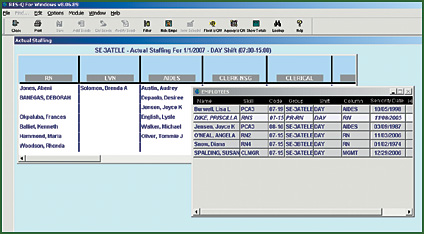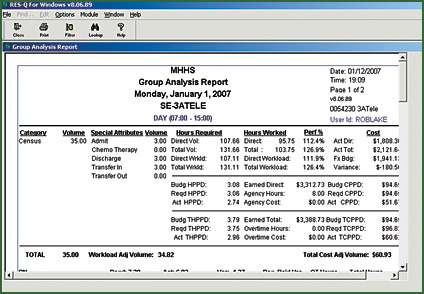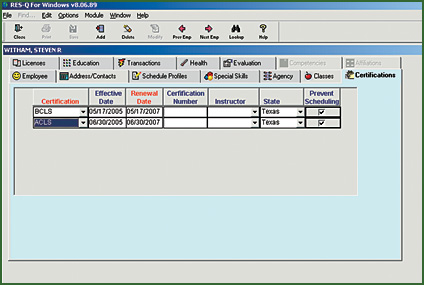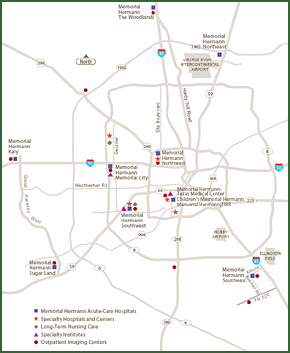The Role of Enterprise Staffing and Scheduling in Quality Assurance
March / April 2007
The Role of Enterprise Staffing and Scheduling in Quality Assurance
Memorial Hermann Health System in Houston, Texas, includes 10 acute care hospitals with more than 3,000 licensed beds. The medical staff totals more than 5,300 physicians, and the system’s workforce consists of 18,000 employees. Like all large health systems across the country, Memorial Hermann faces the challenge of finding creative solutions to the cost and quality problems stemming from the nationwide nursing shortage. For Memorial Hermann, excessive utilization of outside agency staff was one such problem. It was a cost issue because by 1999 outside nursing agency staffing averaged approximately 60,000 registered nurse hours per month, at a monthly cost of $2.4 million. It was a quality concern because external staffing agencies do not consistently evaluate nurses’ backgrounds and skills. Moreover, outside agency nurses vary in their understanding of Memorial Hermann patient care policies and procedures.
Memorial Hermann solved this problem in 2000 by creating Premier Staffing, our own internal staffing agency (Blake, 2006). With a field staff of 1,200 supplemental employees, who are available to provide coverage on an as-needed basis, Premier Staffing operates 24/7 to supply staffing to all Memorial Hermann facilities. We perform rigorous pre-employment testing and conduct comprehensive orientation and training. Thus, when Premier Staffing schedules a supplemental nurse, unit managers in our facilities are confident that we have sent them an appropriately credentialed, licensed, and trained health professional who knows Memorial Hermann policies and understands our standards of care. The results? Memorial Hermann has reduced the use of outside agency nurses and other allied health professionals by 75%, and net system-wide savings now average $1.04 million per month.
|
Implementation of an enterprise-wide, Windows-based client/server software system for staffing and scheduling has proven to be a critical success factor. Memorial Hermann has around 500 licensed application users. With all the hospitals using one staffing and scheduling system and sharing a common, unified database, Premier Staffing can stay on top of open shifts and staffing needs across the entire system 24/7.
The data resulting from the application of staffing and scheduling software is a strategic asset that identifies opportunities to improve the efficiency and effectiveness of resource utilization and to present these opportunities to senior-level hospital directors and executives (Paul, 2006). In addition, Memorial Hermann has found that analysis of this data is a vital resource for internal quality assurance and the Joint Commission on Accreditation of Healthcare Organizations (JCAHO) survey process.
New Visions-Shared Pathways
Under the New Visions-Shared Pathways review process, JCAHO surveyors choose “tracers” and follow specific cases for selected patients over the 3- to 4-day survey period. Tracers may be patient-oriented or system-oriented, depending on the particular process selected for review. The tracer methodology (Halvorsen 2004) is the primary means by which JCAHO surveyors determine if a hospital is following its own policies and procedures and meeting national standards. By following a patient as care is delivered between departments and across service lines, the JCAHO team interacts with caregivers all along the way. The number of tracers depends on the hospital’s scope of services, organizational complexity, the length of the survey and the number of surveyors participating.
Some tracers focus on the management of human resources. For example, facilities are required to provide an adequate number of staff; provide competent staff; orient, train, and educate staff; and assess, maintain, and improve staff competence. High on the list of potential problems for a hospital is the use of agency staffing personnel who are not employees of the hospital. These are the individuals least likely to know the policies and procedures of a hospital and place the hospital at-risk for a mediocre accreditation survey result. Data from the application of enterprise software during day-to-day staffing and scheduling provides information for evaluation of tracers.
Data Reporting Examples
Using our enterprise-wide staffing and scheduling system, Memorial Hermann is able to track the number of employees working in a specific area during any time period. By building interfaces to other key software programs (such as the general ledger, admission/discharge/transfer system, and our time and attendance software), the number of staff can be compared to the number of patients on the unit. In this way, Memorial Hermann can establish a standard of care, defined as the number of patients cared for per individual caregiver, and monitor this standard in real time. When variances in patient care are discovered, Memorial Hermann can review staffing patterns down to the individual practitioner for possible answers to the variance. In other words, the data help us manage staff-to-patient ratios in real time and to demonstrate compliance with staffing ratio standards, whether for purposes of internal quality assurance or JCAHO accreditation surveys.
Figure 1 shows the actual staffing report for a unit for a specific date on the calendar. As shown, drop-down menus display key information about each employee present on this schedule. Figure 2 (Group Analysis Report) shows productivity information and brings together hours worked, patient volumes, costs, and so on to assess productivity for a patient care area. These two reports give a manager the information necessary to determine whether adequate numbers of staff were or were not available to care for the needs of the patient population served.

![]()

![]()
With respect to competency, any patient care unit in Memorial Hermann can set competency, skill, and experience expectations. All of these criteria can be held within the enterprise-wide scheduling system. Should a practitioner not possess the requisite skills and competencies, the scheduling system blocks the practitioner from being scheduled in that area. Using a function called “prevent scheduling,” the unit management staff can manage a practitioner’s access to working on the unit.
Of particular importance to Memorial Hermann is the ability to set requirements for initial assessment of competency and annual reassessment of competency for each practitioner that are tailored to the needs of the patient population being served. Our scheduling system has the capability of documenting these activities in such a way that prevents a practitioner from working without the required competency activities being completed. The competencies can be updated annually or more often if needed. Again, using the “prevent scheduling” functionality, a practitioner may work if, and only if, the requirements are met. This process can be expanded to incorporate non-employee agency staff as well, further enhancing the capability of the unit managers to use only qualified and competent staff to care for their patients.
Figure 3 shows a single employee’s file where certification status information is maintained, such as Basic Life Support (BLS) and Advanced Cardiac Life Support (ACLS). A drop-down menu presents certification status with each certification noted with the effective date and the expiration date. The column marked “prevent scheduling,” once checked, will not allow this employee to be scheduled for work beyond the date of expiration of his or her certifications. The number and type of certifications are defined by unit according to the skill level of the nurse and the competencies he or she holds for a specific clinical area. Thus, access to data maintained in our staffing and scheduling system enables Memorial Hermann to ensure in real time that scheduled nurses and other health professionals have required competencies. We can also use the information confirm that we do so for our own quality assurance efforts, as well as JCAHO review.

![]()
Discussion
The use of a system-wide scheduling system to manage the large amount of data needed to provide qualified practitioners for patient care is critical to the success of Memorial Hermann. The scheduling system is deployed throughout the organization, and it is available to all departments. Once competency criteria are set, these criteria can be entered into the scheduling system, calibrated according to each practitioner, and used to determine which individuals possess the needed skills to work in a clinical area. The minutes required to upload this information save hours of time in looking through skills checklists and other documents to make this same determination manually.
With a variable labor pool of the size needed to manage the staffing needs of Memorial Hermann, the ability to quickly determine the capability of a single practitioner is critical to successful management of our internal staffing solution. Employees are satisfied that they are getting the amount of work they desire. They also take a certain ownership in being competent to take on the patient care needs of a highly diverse patient population. Moreover, managing the evaluation needs of this variable labor pool is enhanced by using its functionality to capture critical education, training, and attendance at skill fairs. Tracking attendance and punctuality is enhanced by using standardized measures for tardiness and absenteeism. In this way, the best of the best can be quickly found for a given staffing need.
Using an enterprise-wide scheduling system allows Memorial Hermann to track its employees in terms of the competencies and certifications needed to perform work and does not allow individuals who do not possess the requisite skills and abilities to be scheduled. Managers and directors can spend more time providing leadership to their employees and less time keeping track of the documentation necessary to support such a system. Accrediting agencies can be shown both the electronic record and the employee’s hardcopy file to check the results of the system. The patients and their families can be assured that caregivers are qualified to care for them. In conclusion, an enterprise system for staffing and scheduling manages and provides data that is an essential resource for internal quality assurance and the JCAHO survey process.
References
Blake, R. (2006). Scheduling software supports cost-saving staffing alternative. Health Management Technology, 27(12), 34-35.
Paul, B. (2006). Strategic scheduling. ADVANCE for Health Information Executives, 10(8), 14-15, 44.
Halvorsen, M. (2004). Tracer methodology: Frontline strategies to prepare your organization for JCAHO survey. Marblehead, MA: HCPro.

